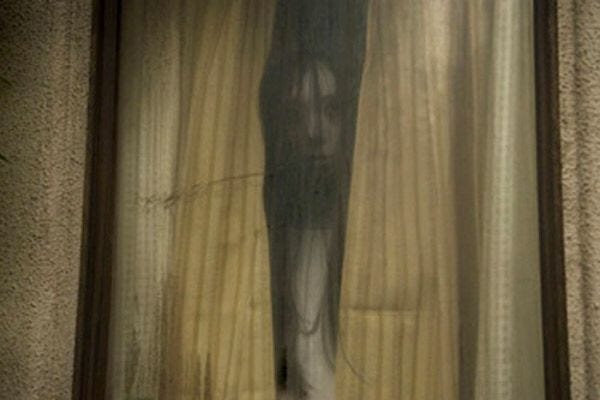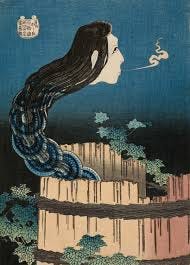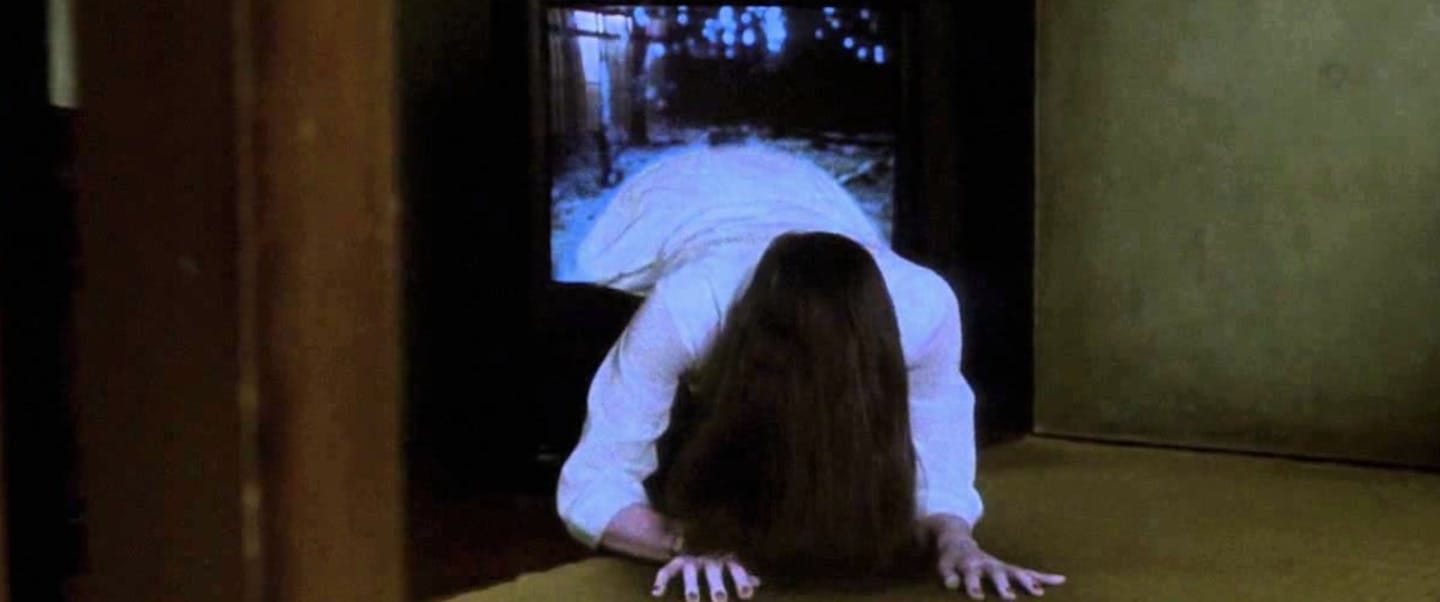who is scared of the long-haired woman?
why the long, black-haired japanese ghost girls are so terrifying
this article contains a lot of horror images of japanese ghost girls. don’t read at night, or Mother might come and haunt you…..
i watched a lot of horror movies as a kid, but the first one that truly terrified me was the ring (2002). funnily enough, even though I grew up in asia, the version I saw was the american remake. that scene with the girl in the white dress, hair covering her face, crawling out of the well and through the tv screen burned itself into my 12-year-old brain like a cursed vhs. i didn’t sleep that night. or the next. or for many nights after.
a few years later, when i was sixteen, i watched the original japanese version. that shit was even more horrifying. the woman ghost and her long black hair, stained white dress, slow movements and static mouth noises, i couldn’t get that out of my head. i couldn’t even go pee without turning all the lights on. it’s almost embarrassing how fast i crumble under the power of women, especially when they’re powerful and silent.
it got me thinking: why does this specific image haunt me so much? the western horror movies never do it for me: sure i jumped at that scene in insidious 1, and covered my eyes during the haunting of hill house, but that fear was fleeting. the long-haired ghost women draped in silence and soaked in grief, on the other hand, lingered.
history
reddit spiral led me to r/history, where an intelligent reddit wizard told me the history of the girl in the ring. it is said that this imagery is directly inspired by a japanese ghost story called “okiku and the nine plates.” the story goes: okiku accidentally broke some expensive plates of a very, very rich family (or she was framed for it), and as a result, she was thrown down a well. late at night, okiku emerged from the well, with dripping wet hair, tracing the steps counting the plates she had broken.
the ring’s ghost belonged to a wave of what is defined as “new asian female ghost films". during the late 1990s to the early 2000s, there were an array of horror films from japan, south korea, thailand, hongkong, and singapore portraying the main antagonist as prematurely dead women returning as vengeful spirits.
these ghosts come at a time when asia was haunted. the 1997 asian financial crisis led to a more personal one: a paternal, overall male crisis of unemployed fathers and emasculated men. this resulted in a shift in the familial dynamic, where the mothers have to gain autonomy, contributing actively to the family’s income, sometimes even becoming the breadwinner. because of this rise in female autonomy, society does what it does best: villainize women into haunting, over-possessive figures.
are you scared of Mother?
these women ghost figures often represent the archaic mother archetype in jungian psychology (i’d like to play a game that whenever jung pops up anywhere, i’m humbly reminded that he might be right about the mother thing). barbara creed and julia kristeva (insert year) hypothesizes that there is a special bond between mothers and their children before the father enters the picture, which is known as the pre-oedipal stage. the archaic mother type in asian horror movies is the symbolic representation of where this bond lingered for too long, where the mother becomes engulfing and over-possessive.
these woman ghost figures are terrifying not because they are destructive killing machines, but because they dissolve identity. they want you back in the womb basically. for instance, in ju-on: the grudge (2002), the main ghost girl and murdered mother kayako channeled her rage through a curse in the house. anyone that enters the house is destined to die. in this case, the house is a womb of death: you enter her womb, you lost yourself and become whole with the mother. once again jung was right damn it.
another reason these ghosts are so terrifying is that they disrupt conventional male logic. in many of these films, the men—scientists, detectives, fathers—fail to solve the mystery or defeat the ghost. they're often killed or rendered powerless. even when the protagonist isn't male, their downfall stems from relying solely on rationality over intuition or emotion. these ghosts, symbolic of repressed female autonomy, cannot be exorcised through logic alone: you also have to reason with emotions. for example, in ringu (1998, the og the ring movie), the female journalist and her scientist ex-husband thought they had solved the case by finding the body of the ghost. however, the curse continued: the tv turned on by itself, and the female ghost crawled from the well outside the tv screen, killing the ex-husband. it was only then that the journalist realized the actual way to avoid the curse is to pass the tape on, showing the tape to someone else.
one thing asian horror does better than its western counterpart is the ability find horrors from our everyday lives. you might not be scared of an apocalypse, zombies, or monsters, but we are all scared of unresolved maternal trauma righttttt. moreover, asian ghost figures often do not rely on scary physical appearance but on our fears of the unknown. the ring’s girl has her face covered with her long hair. in incantation (2022), the ghost is an invisible force, a cursed cave. a good rule of thumb for horror movies: humans are always scared of what they can’t see or understand.
american remakes—what’s left in japan?
as we have discussed, the origin of the ring female ghost is deeply tied with the asian socio-economic context of the time. most of this context, and the horror occupying it, is lost in the american remakes and replaced by its own form of horror.
firstly, there are the changes to the ghosts’ physical appearances: the ghosts are more visibly monstrous, with zombie-like features like tongues and slow, dreadful walking. but the ghosts become soulless, relying on physical appearance to create horror. i think this is a big loss, because i am not scared of zombies. i think i can take on one of those girls any time of day. Mothers, on the other hand….
there’s also a distinctly orientalist lens to how asian female ghosts are portrayed in these western remakes. historically, asian women in hollywood have fallen into two tropes: the submissive, innocent girl-next-door or the exotic, calculated “dragon lady.” but in the wave of asian horror remakes, these archetypes are mashed into something new—the ghostly woman who is irrational, desperate, and emotionally unhinged. she isn’t just haunting the protagonist; she’s in love with him. her silent, obsessive longing becomes monstrous. she stalks, clings, kills—not out of revenge, but because she wants to possess him entirely.
an example, also the most unrealistic movie plot of all time, is the grudge (2004). in the movie, kayako, a japanese mother, fell in love with her son’s teacher, an american professor named peter. she became obsessed, writing love letters, mentioning him in her diary, causing her husband to become so jealous he murdered her. i’m gonna stop the paragraph here because i genuinely don’t know how to feel or what to write next. (they couldn’t give a better name than peter?? we’re supposed to root for a guy named peter kirk?)
the remakes replace the source of horror from wounded trauma with Mommy to westerners’ fear of alienation. often, in these remakes, western characters have to solve a curse they don’t know the cultural context of. they have to decipher messages in japanese, surrounded by amulets they don’t recognize, and being haunted by a ghost whose names are hard to pronounce. i’d quake too if i’m haunted by a nun named kayleigh or something, so i totally get their fears. the source of horror in these western remakes shift from familial dread towards the terror of being lost in translation.
writing this piece made me realize that i am so deep in the japanese horror rabbit hole. your girl is FASCINATED;;;;;
so i will write a part 2 to this article, focusing on japanese “mockumentaries,” next week. i will be looking at the youtube channel reignbot and this dazed article on “japanese films about filmmaking.”
read along!! also, if you have any nice materials about this topic, please leave it in the comments. last time a reader sent me their partner’s report on luxury fashion and another introduced me to yiddish theater makeup. i was gagged. please keep them coming!!!!!!!!!!!!!!!!!!!!!!!!!!!!!!!!!
sources
Lee, H. (2024). Transformations of the monstrous feminine in the new Asian female ghost films. Diogenes, 62(1), 100–114. Cambridge University Press. https://doi.org/10.1177/0392192117701387
u/AskHistorians. The ghost girl or demon in the guise of a girl is a very common motif in East Asian horror. What is its origin?









I had no idea the wave coincided with the ‘97 financial crisis! That’s enlightening. I’ve been meaning to dig into that since that’s when my family went bankrupt and moved to the states. Can’t wait for part 2 and to contextualize Mikio Sakabe’s show in Tokyo with this in mind. (He used models with long hair and the reference was definitely to horror).